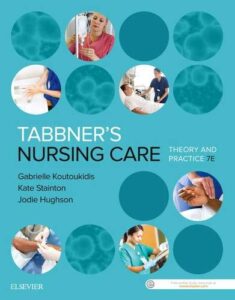Description
Test Bank For Tabbner’s Nursing Care Theory and Practice 7th Edition
Chapter 01: Nursing: the evolution of a profession
Test Bank
MULTIPLE CHOICE
1. Nursing is a unique profession because it addresses responses of individuals and
families to:
a. compassionate treatment.
b. health promotion, health maintenance and health problems.
c. Florence Nightingale’s theories.
d. all of the above.
ANS: B
Nursing is a unique profession because it addresses responses of individuals and families
to health promotion, health maintenance and health problems. Nursing is also seen as
being important for both the provision of safe, quality care and for the humane,
compassionate treatment of the individual.
2. The period that has been termed the ‘Dark Ages’ of nursing was from:
a. the beginning of the 18th century to the middle of the 19th century.
b. the end of the 17th century to the middle of the 18th century.
c. the end of the 16th century to the middle of the 18th century.
d. the beginning of the 15th century to the middle of the 16th century.
ANS: A
The period between the beginning of the 18th century to the middle of the 19th century
was termed the ‘Dark Ages’ of nursing because care of the sick and the status of the
nurse reached the lowest possible levels (where undesirable characters tended the sick in
squalid hospitals).
3. Florence Nightingale was also known as:
a. the Lady of the Lake.
b. the Lady of Crimea.
c. the Lady of the Lamp.
d. the Angel of Hygiene.
ANS: C
Nightingale was known as the ‘Lady of the Lamp’ as she carried a lamp at night and
brought comfort and ease to the very sick in Crimea.
1
Test Bank For Koutoukidis: Tabbner’s Nursing Care: Theory and Practice, 7th Edition
Chapter 01: Nursing: the evolution of a profession
4. The Australian Nursing Federation (ANF) was established in:
a. 1901.
b. 1910.
c. 1924.
d. 1946.
ANS: C
The Australian Nursing Federation (ANF) was established in 1924. It is the national
union for nurses and the largest professional organization in Australia.
5. New Zealand’s original Nurses Registration Act was passed in:
a. 1901.
b. 1910.
c. 1924.
d. 1935.
ANS: A
New Zealand was the first country to have separate legislation for the registration and
regulation of nurses, which was passed in 1901.
6. How many years did Benner predict that it would take to move from novice to expert
practitioner?
a. 1–2
b. 2–3
c. 3–5
d. 5 +
ANS: D
Benner predicted that it would take 2–3 years to become a competent practitioner, and 3–
5 years to become a proficient practitioner. It would thus take at least 5 years for most
nurses to become expert practitioners.
7. What is the major professional organization that represents nursing in Australia?
a. Australian Nursing Federation.
b. Australian College of Nursing.
c. Nurses Board.
d. International Council of Nurses.
ANS: B
In 2011 the Royal College of Nursing, Australia (RCNA) and The College of Nursing
(TCoN) united to become the Australian College of Nursing (ACN). The ACN provides a
strengthened base for the nursing profession that communicates with government, other
sectors, and the public. It fosters research, policy, and strategic development and provides
a foundation for professional development and education activities.
8. Nursing education in Australia is regulated by:
a. ANMAC
b. NMBA
c. AHPRA
d. all of the above
ANS: D
Nursing education in Australia is regulated by ANMAC, NMBA, and AHPRA. Education
providers are required to deliver courses that meet the accreditation standards of
ANMAC and are approved by the NMBA. Students must also be registered with AHPRA
by their education provider. Both these organizations play a key role in protecting the
public.
9. The main change that has influenced healthcare in recent decades is:
a. increasing lifespan.
b. higher incidence of long-term illness.
c. increased incidence of diseases caused by substance use.
d. all of the above.
ANS: D
Changes also include the move from rural to urban centers. Healthcare must also change,
and may thus need to change the educational emphasis and establish new practice
standards.
10. Nurses attain increased autonomy through:
a. high levels of education.
b. clinical competence.
c. practicing in diverse settings.
d. all of the above.
ANS: D
Nurses are increasingly taking on independent roles in nurse-run clinics, collaborative
practice and advanced practice settings (such as Nurse Practitioners).

Reviews
There are no reviews yet.